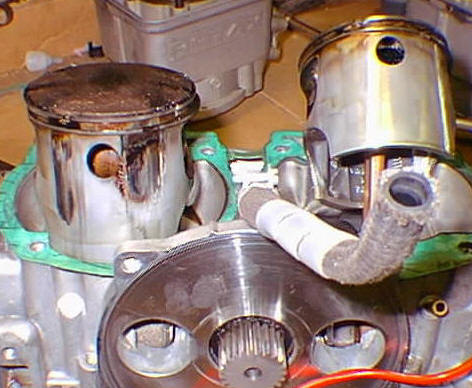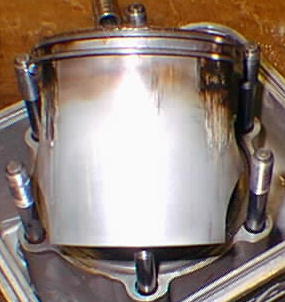Rotax 582 cold seizure, cold seizure can happen on an aircooled or water cooled engine. |
|||||||||||||||||||||||||||||||
|
|||||||||||||||||||||||||||||||
|
|||||||||||||||||||||||||||||||
United Kingdom
|
|||||||||||||||||||||||||||||||
AAIB Bulletin No: 11/96 Ref: EW/G96/09/03 Category: 1.3
|
|||||||||||||||||||||||||||||||
|
This was the first flight of the aircraft following a 150 hour service
which had included a complete strip down and re-assembly of the engine
being carried out by an approved maintenance organisation. The weather for
the flight was good with excellent visibility, no significant cloud, a
temperature of 15ºC and a surface wind of 360º/10 kt. The engine behaved normally during the start-up and taxy and the pilot stated that it had been running for about 15 minutes prior to the take off on Runway 06. During the take off the peak RPM was achieved as normal but at 200 feet agl the engine failed without any warning. There was insufficient runway remaining so the pilot decided to land in a field immediately ahead. A gentle touchdown was made about one third of the way into the field and at a normal speed but the wheels immediately sank into the soft, recently ploughed surface. The right main gear was torn off, the right wing tip hit the ground and the aircraft came to a complete stop in about 10 metres. The pilot and his passenger, who were wearing full harness assemblies, were uninjured and vacated the aircraft via the normal exits. The maintenance organisation that had completed the 150 hour service requested that the engine be examined by an independent organisation with experience of the Rotax engine. Initial inspection of the engine by the main UK agents for Rotax showed classic signs of cold seizure at four different places around the circumference of the cylinder. A cold seizure can occur if an engine is run at full power before it is fully warm, the piston then expands faster than the cylinder leading to the seizure. |
|||||||||||||||||||||||||||||||
|
How cold seizure happens. The text below is reproduced from a posting to the BMAA eGroup, where a member helpfully shared this information - which comes from a Rotax expert.
First the term "cold seizure" is a bit of a misnomer. All
seizures are caused by heat/friction. A cold seizure is where the piston
expands faster than the bore it is traveling in and contacts the sides of
that bore. These are also known as four corner seizures.
lose rpm for a second or two, or it may bring the engine to a complete stop. Once the engine has cooled down a bit it will appear to re-start and run properly. Don't let this fool you. More than one person has tried to fly his plane out of a field where they had to land because the engine quit, only to have the engine fail again in short order.. unfortunately, the second failure usually happens when the pilot has fewer options for a safe off field landing. Don't let "get home itis" bite you. Find out why the engine stopped before you carry on.. After all,
the "self fixing engine" has not yet been invented. One obvious one, would be
a lack of warm up prior to going to full throttle. Also, long extended
descents at low power settings followed by a high power run (go around)
can also contribute/cause the problem. A major cold seizure (complete
stoppage of the engine) can occur as a result of multiple mini seizures
finally causing a big time stoppage of the engine. On a Rotax 582 liquid cooled engine a cold seizure is not usually visible through the exhaust port, and you can not see the piston on the intake port side. You can see a seizure cause by lack of lubrication from the exhaust port. On a cold seizure, there will be vertical scuffing towards to outside
edges of the piston as viewed through the exhaust port. There will be two
corresponding vertical scuffs on the intake side, but these cannot be
viewed without removing the cylinders.. If the engine has experienced a
cold seizure these marks will be visible through the exhaust ports. To help prevent cold seizure, make sure your engine is equipped with the proper gauges, CHT, EGT, Water Temperature, and tachometers are the basic instruments. For more on instruments and why you need them - Click here |
|||||||||||||||||||||||||||||||
|
|
|||||||||||||||||||||||||||||||
Ultralight
Aircraft News Magazine |
| ||||||||||||||||||||||||||||||



